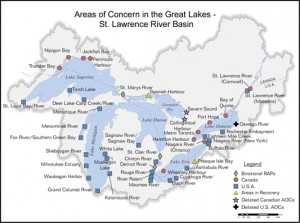
Forty-three Great Lakes polluted sites were identified by the U.S. and Canada as Areas of Concern.
The rise of the Great Lakes Restoration Initiative in the U.S. has begged the question: what is Canada doing to restore its 2,904 miles (4,797 counting islands) of Great Lakes shoreline?
The Toronto Star, Canada’s biggest newspaper, asked that of its own government in a February editorial responding to the states’ $2.2 billion Great Lakes plan:
“So, where is Canada’s plan?” they ask. “Troublingly, it seems our federal government is not nearly as concerned about the health of the lakes.”
But, sweeping strategic plans aside, Canada actually leads the U.S. on Great Lakes restoration in at least one measure.
On Friday, Canada crossed off Wheatley Harbor from its list of Areas of Concerns — a group of Great Lakes rivers, harbors and bays with enough pollution and degraded habitat to warrant a special classification from the Canadian and U.S. governments.
That’s the third such site Canada has cleaned up and checked off its original list of 12. The U.S. has only knocked one site off its list of 26.
The two countries share five more sites, all of which are still on the list.
Keeping score probably isn’t the best way to foster binational cooperation over Great Lakes restoration. It also ignores the cleanup challenges that a particular Area of Concern may face that another may not.
But in the world of Great Lakes pollution hot spots, delisting is politically the most powerful measure of progress. An infusion of cash through the Great Lakes Restoration Initiative may give the U.S. a leg up in the future. But for now, Canada is up three to one.